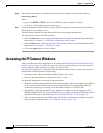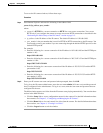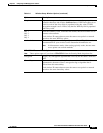
3-2
Cisco Video Surveillance 2500 Series IP Camera User Guide
OL-19273-02
Chapter 3 Configuring and Managing the IP Camera
Configuration Overview
Ta b l e 3-1 Guidelines for Configuring the IP Camera
Configuration Item Explanation Guidelines for Use Reference
IP camera name and
description
Identifies the IP camera. Recommended. See the “Basic Setup Window”
section on page 3-5.
LED operation Determines whether the LEDs
on the front of the IP camera
light or remain off.
Optional. See the “Basic Setup Window”
section on page 3-5.
Time information Sets the date and time for the IP
camera. Also determines how
the IP camera obtains the date
and time, its time zone, and
whether it adjusts for daylight
saving time.
Recommended. See the “Basic Setup Window”
section on page 3-5.
Network options Determine how the IP camera
obtains its IP address, and
provides options for configuring
subnet mask, gateway, and DNS
servers.
IP address is required if DHCP is
not enabled in your network,
other items depend on your
network configuration.
See the “Basic Setup Window”
section on page 3-5.
Wireless options
(wireless model only)
Set various communication and
security options for the wireless
IP camera.
SSID is required, security
options are recommended.
See the “Wireless Setup
Window” section on page 3-7.
Advanced network
and protocol options
Determine whether the IP
camera uses Cisco Discovery
Protocol (CDP) and it uses
Bonjour, configure alternate
ports for HTTP or HTTPS
connections, configure RTP or
RTSP options, and configure
QoS.
Optional, depending on your
network and requirements.
See the “Advanced Setup
Window” section on page 3-11.
IP address filters Controls access to the IP camera
by IP address.
Optional. See the “IP Filter Window”
section on page 3-14.
EAPOL Configures Extensible
Authentication Protocol Over
LANs (EAPOL) for
authenticating and controlling
user traffic to a protected
network
Optional. See the “EAPOL Window”
section on page 3-14.
IP camera users Sets the password for the IP
camera administrator, and sets
log in credentials and privileges
for up to 20 users.
Optional. See the “Users Window” section
on page 3-16.


















